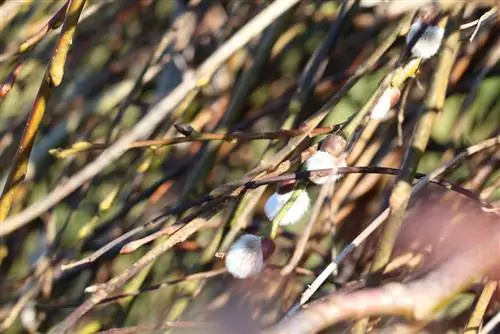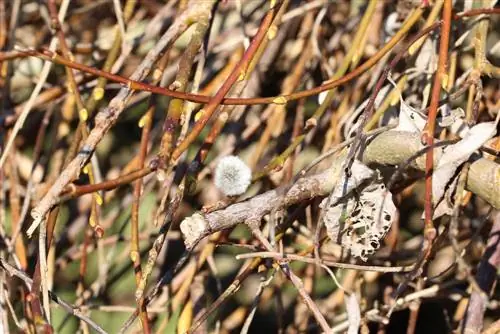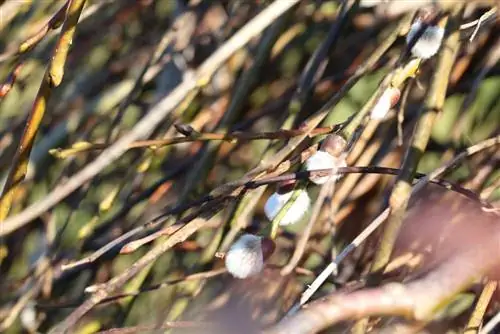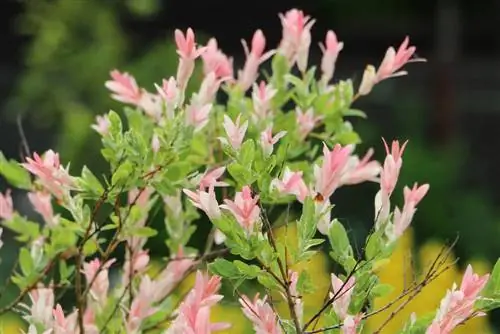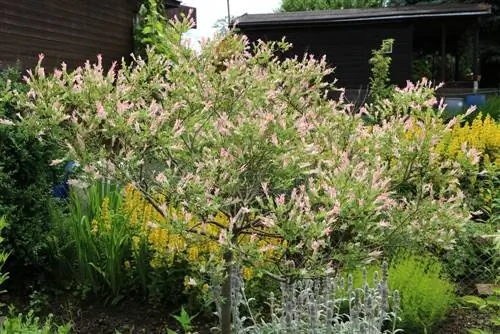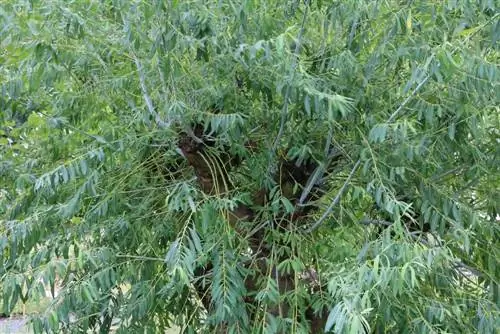- Author admin [email protected].
- Public 2023-12-17 03:39.
- Last modified 2025-06-01 06:48.
The Salix genus is one of the oldest pre-glacial plants, meaning it existed 300 million years ago, and around 70 of these Salix species developed in our climatic region.
Ecological importance of the Sal willow (Salix caprea)
These native willow species have a particular ecological importance because many willows bloom very early in the year. The willow usually shows its catkins from the beginning of March, even before it unfolds its leaves. This makes it one of the first plants to provide food for the insects that are currently swarming. The hanging catkins are the first food for bees (for 34 different wild bees), the willow remains important for the local butterflies all year round - almost 100 species of butterflies live on the willow, including many that are threatened with extinction, and 16 mammals also feed on it the sal willow.
The suffix also refers to the willow as a food plant - caprea is Latin and means goat, and it likes to eat the shoots of the willow so much that woodcuts from 1595 depicting a goat are still available today, feeding on a willow tree.
It is not without reason that the goat has chosen the sal willow among all types of willow. In contrast to many other willows, this willow thrives not only in swamps or other wet areas, but exactly the other way around, exclusively outside such “mud puddles” on “solid Floor”.
The right location for a willow tree (Salix caprea)
This provides clues to the correct location of a willow tree in the garden:
- Sal willow grows on any reasonably nutrient-rich site; it also grows as a pioneer plant on fallow land and rubble heaps. It can be assumed that it will find enough nutrients in every spot in your garden.
- It likes fresh and almost every other climate, it only doesn't feel comfortable in the warmest south of Europe anymore, but unfortunately it doesn't get that warm in our gardens anywhere in Germany.
In other words: You can place a willow in your garden completely freely, as long as it gets a little sun every now and then in the chosen location, but you would have to think a little into the future: willows live on average 30, in extreme cases up to up to 60 years old and up to 10 meters high, your pasture will also develop powerfully in width. If you don't want to constantly work on it with the secateurs, it should be given a little space to spread.
Care and disease management for the Sal willow (Salix caprea)
There really isn't much need to be said about caring for the willow:
- If you have given it an occasional sunny spot and no moisture accumulates in the ground, your willow tree should thrive without any problems.
- A little caution is recommended if you want to heavily lime a lawn right next to the pasture. It doesn't like too much lime, so it's probably better to determine the exact pH value first.
- If a willow loses leaves or they get brown spots, this indicates a fungal infection; the location has probably become too moist at some point.
Then you should cut back all affected shoots down to the he althy wood, rake up fallen leaves and dispose of all loose plant parts in the trash (not in the compost). If the location tends to be waterlogged, sand may be added to the soil to ensure better water permeability.
Otherwise, you might encounter another red or yellow beetle with black spots or a black beetle on your willow tree, all of which are willow leaf beetles. Normally, you can simply wish these beetles “Enjoy!” when nibbling the leaves, because the willow would sprout again even if it were completely eaten, and the birds in your garden are already waiting to take care of the “problem”.
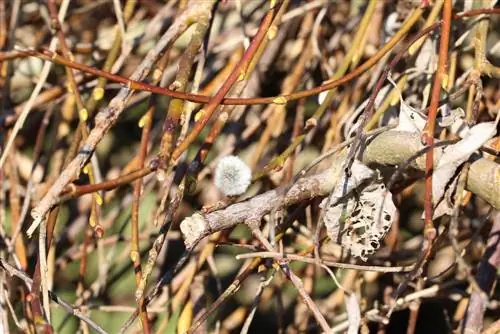
If this doesn't happen and your tree is in danger of "collapsing" under the beetles, some insecticides approved for home and allotment gardening that contain pyrethrins (a chrysanthemum poison) and rapeseed oil are said to be able to spoil the taste of the beetles, e.g. B. Spruzit AF pest-free from Neudorff, Bayer Garten organic pest-free AF or Compo pest-free plus. However, out of consideration for your own he alth and that of those around you, you should only purchase such insecticides from specialist retailers, clearly stating the intended use, and you should also carefully follow the instructions for use on the packaging in the garden.
Pruning the sal willow
- By pruning the young plant, you decide whether your willow will become a tree or grow into a large shrub with several strong main branches.
- Both forms should receive occasional care pruning, where you can cut back heavily - a willow will keep sprouting.
- Because that's the case, you can wait until the willow has "almost outgrown your head" with this care cut.
- However, this pruning is also recommended occasionally if your willow tree has all the space in the world to grow, otherwise it will eventually become too bare and older shoots will bloom less and less over time.
Propagate sage willow
If you would like to establish more willows in your garden and find out about the possibilities of propagation on the Internet, you will most likely read that, unlike other species, willows can hardly be propagated from willow cuttings. If you want more willow trees, don't believe that, just try it. Not much can happen, if the cutting hasn't rooted after a year, it just goes into the compost. The other variant of propagation that should work safely is collecting seeds and then sowing these seeds again; the small seedlings should grow willingly and very quickly.
The “double sal willow” - the hanging pussy willow
The hanging kitten willow has a particularly attractive way of presenting itself. This is a willow or a wicker, onto which a willow has been refined. The crown of this “Salix caprea Kilmarnock” can only develop above the grafting site, which leads to a special growth form in which the catkins grow hanging downwards. In addition to the nickname “Kilmarnock”, this special form of willow is also called Salix caprea “Pendula” or “Weeping Sally”, the last being the female form, which is said to bloom a little less beautifully than the “male”.

